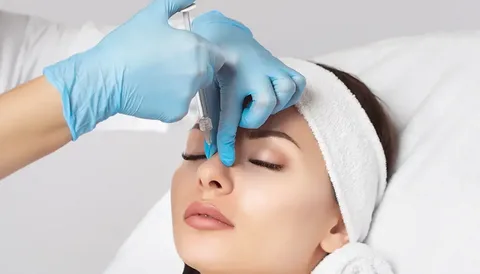Dubai, a city known for its luxury and cutting-edge medical facilities, is also a popular destination for rhinoplasty, commonly referred to as a nose job. This surgery can reshape the nose for aesthetic or functional purposes. While the procedure itself is a significant step, the recovery period is equally important for achieving optimal results. Here's a comprehensive guide to navigating your Rhinoplasty in Dubai ( تجميل الأنف في دبي ):
The Immediate Aftermath: Managing Discomfort and Swelling
The first few days after surgery are critical for setting the stage for a smooth recovery. You can expect some swelling, bruising, and discomfort around the nose. Here's how to manage these initial symptoms:
- Prioritize Rest: Your body needs all its resources dedicated to healing. Take ample rest, ideally with your head elevated on extra pillows. This helps reduce swelling and promotes drainage.
- Embrace the Ice: Cold compresses applied to the sides of your nose can significantly reduce swelling and alleviate pain. Wrap ice packs in a thin towel to avoid direct contact with the skin.
- Medication Management: Your surgeon will prescribe pain medication and possibly antibiotics to prevent infection. Take these medications exactly as directed to manage discomfort and promote healing.
Keeping it Clean: Hygiene and Incision Care
Maintaining proper hygiene is crucial to prevent infection during recovery. Here's what to keep in mind:
- Follow Cleansing Instructions: Your surgeon will provide specific instructions on when and how to clean your nose. Avoid touching or blowing your nose unless instructed to do so. Gentle cleaning with a saline nasal spray can help keep the nasal passages moist and clear.
- Splint and Cast Care: Splints or casts are often used to support the new nasal structure during healing. Don't attempt to remove these yourself; your surgeon will take care of it during follow-up appointments.
- Showering Cautiously: Avoid submerging your face in water for at least a week after surgery. Opt for gentle sponge baths or use a washcloth to clean your face, taking care to avoid the nose.
Dietary Do's and Don'ts: Fueling Your Recovery
What you eat can significantly impact your healing process. Here are some dietary tips to promote optimal recovery:
- Hydration is Key: Drink plenty of water throughout the day. Dehydration can hinder healing and worsen swelling.
- Choose Nutrient-Rich Foods: Focus on a balanced diet rich in fruits, vegetables, and whole grains. These foods provide essential vitamins and minerals needed for healing.
- Avoid Inflammatory Foods: Limit your intake of processed foods, sugary drinks, and excessive salt, as these can contribute to inflammation and swelling.
- Maintain a Soft Food Diet: Stick to soft foods that are easy to chew during the first week of recovery. This will minimize pressure on the nose and prevent irritation.
Getting Back to Normal: Activity Restrictions and Exercise
While rest is crucial, prolonged inactivity can also be detrimental. Here's how to gradually reintroduce activity into your routine:
- Limited Movement: Avoid strenuous activities, heavy lifting, and bending over for at least two to four weeks after surgery. These activities can put undue stress on the healing nose.
- Exercise on Hold: Hold off on any strenuous exercise routines for at least four to six weeks. Gentle walks and light cardio can be resumed with your surgeon's approval.
- Sleeping Positions: Avoid sleeping on your stomach for at least eight weeks. Sleeping on your back with your head elevated helps reduce swelling.
Sun Safety and Avoiding Irritants: Protecting Your New Nose
The sun's ultraviolet rays can damage the healing tissues and cause hyperpigmentation. Here's how to protect your nose:
- Embrace Sun Protection: Once you're out and about, wear a wide-brimmed hat and apply sunscreen with SPF 30 or higher to your face, especially around the nose.
- Beware of Irritants: Avoid dusty environments, smoke, and secondhand smoke, as these can irritate the nasal passages and hinder healing.
- Eyewear Considerations: For the first few weeks, avoid wearing glasses that rest on the bridge of your nose. Opt for contact lenses or glasses with a different frame style.
Patience is Key: Managing Expectations During Recovery
Remember, rhinoplasty results take time to fully reveal themselves. Here's what to expect during the recovery timeline:
- The First Week: Expect significant swelling and bruising. You may experience some difficulty breathing due to internal splints.
- Weeks 2-4: Swelling and bruising gradually subside. You may regain a sense of normalcy in your daily activities.
- Months 3-6: Subtle refinements continue as swelling further diminishes.
Conclusion: Rhinoplasty Recovery Tips in Dubai
Rhinoplasty is a transformative procedure that can significantly enhance both your appearance and self-confidence. However, achieving the best possible outcome requires diligent care during the recovery phase. By following these recovery tips, you can ensure a smoother, more comfortable healing process. Prioritize rest, maintain a healthy diet, and follow your surgeon's instructions closely to minimize discomfort and speed up recovery. Staying hydrated, avoiding strenuous activities, and protecting your nose from direct sunlight are also essential steps. Regular follow-up appointments with your surgeon will help monitor your progress and address any concerns. With proper care and patience, you can enjoy the full benefits of your rhinoplasty and the vibrant lifestyle that Dubai offers.





Comments